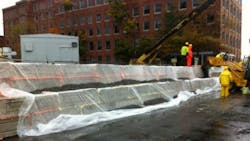As Hurricane Sandy was churning its way up the East Coast, utilities in southern New England were in the final steps of preparing for the worst of the storm and hoping for the best.
Weather forecasters predicted the timing of the strongest winds to coincide with very high tides, which would contribute to widespread flooding along Connecticut shoreline communities. While closely monitoring the forecasts days in advance of the storm's arrival, Connecticut Light & Power (CL&P) began staging crews and protecting facilities located near Long Island Sound.
Substations near the shore were a special concern because the corrosive effects of seawater could knock a facility out for days or even weeks. De-watering underground conduits that carry control cables, and decontaminating and refurbishing aboveground switchgear and circuit breakers is a time-consuming task.
One primary concern was CL&P's South End Substation, located in Stamford, Connecticut. This 115-kV substation serves tens of thousands of customers in the city's center, where emergency services, the city hall and a financial district are located.
With the South End Substation just blocks from Long Island Sound, in a low-lying area, it quickly rose to the top of the corrective actions list for facilities at risk of serious damage from Sandy. Based on updated weather predictions, it became apparent the south end of the city could be threatened by the multiple high tides during a full moon, making the forecast even more ominous.
With two sides of the substation built into the side of a hill and well protected, the other two sides, at street level, were vulnerable. CL&P engineers brainstormed options and came to the creative conclusion of building an unprecedented 6-ft (1.8-m) cement wall around the substation to protect it from any potential storm damage.
On the evening of Oct. 28, 2012, about 12 hours before the first effects of Superstorm Sandy were expected to be felt in Connecticut, CL&P civil engineers drafted plans for a temporary concrete block wall to protect the exposed sides of the substation. Concurrently, CL&P system project team members contacted local construction and crane companies to determine whether resources were available to build such a wall.
The following day, wind speeds began to increase from Hurricane Sandy, and all employees were activated to storm duty, some of whom were reassigned to work with construction contractors to begin assembling the block wall at 6 a.m.
On the morning of Oct. 29, a state of emergency was declared in Connecticut, limiting travel on I-95 to emergency and essential services, which reduced traffic and allowed for faster delivery of the blocks from the concrete plant to the job site.
Additionally, assembly time was saved with an efficient work process developed by the project managers on-site. Crews started building the wall at the lowest corner of the substation (at the intersection of Atlantic and Pacific streets). Once the corner was constructed, the crew was split to facilitate two independent crane crews who worked their way down each side of their respective fence lines, assembling a total number of 600 blocks into a two-tiered wall. As sections of the wall were completed, follow-up crews sealed the seams between the blocks with insulating expandable foam, and then the entire block structure was covered with plastic sheeting for additional waterproofing.
The construction of the wall was completed in 12 hours (at 6 p.m.), about three hours ahead of schedule and about six hours ahead of the first storm tide.
Two high-volume water pumps were installed to evacuate any water from the underground conduits, which carry the high-voltage cable from the substation to the underground network system. Crews staffed the South End Substation during the high tides to monitor conditions and take action if needed.
While the floodwaters were less severe than predicted and never reached the substation, the extraordinary effort to build the wall was a prudent step to prevent outages and a valuable learning opportunity. New England weather can be uncertain and severe, and it is CL&P's goal to be prepared for whatever threat Mother Nature may bring to the system.
